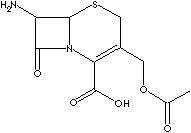PRODUCT IDENTIFICATION

H.S. CODE
TOXICITY
SMILES
N12C(=C(CS[C@@]1([C@@H](C2=O)N)C)COC(=O)C)C(=O)O
CLASSIFICATION
EXTRA NOTES
PHYSICAL AND CHEMICAL PROPERTIES
3.0 ~ 5.0
REFRACTIVE INDEX
EXTERNAL LINKS & GENERAL DESCRIPTION
USA.gov - 7-Aminocephalosporanic acid
Wikipedia Linking - 7-ACA
Google Scholar Search - 7-Aminocephalosporanic acid
U.S. National Library of Medicine - 7-Aminocephalosporanic acid
PubChem Compound Summary - 7-Aminocephalosporanic acid
Drug Bank - 7-Aminocephalosporanic acid
KEGG (Kyoto Encyclopedia of Genes and Genomes) - 7-Aminocephalosporanic acid
ChEBI (http://www.ebi.ac.uk/chebi/) - 7beta-Aminocephalosporanic acid
NCBI (http://www.ncbi.nlm.nih.gov/) - 7-Aminocephalosporanic acid
Hazardous Substances Data Bank - 7-Aminocephalosporanic acid
EPA - Substance Registry Services - 7-Aminocephalosporanic acid
Local:
APPLICATIONS: 7-Aminocephalosporanic Acid [chemically, 3-(Acetyloxy-methyl)-7-amino- 8-oxo-5-thia-1- azabicyclo (4.2.0) oct-2-ene-2-carboxylic acid] is the active nucleus for the synthesis of cephalosporins and intermedaites; obtained by hydrolysis of cephalosporin C. Cephalosporin is a group of broad-spectrum beta-lactam antibiotics iclude cephradine, cephazolin, cephalexin, and cefadroxil (the first generation); cefuroxime, cephamandole, cefaclor, cefprozil, and cefoxitin (the second generation); cefotaxime, ceftazidime, cefodizime, ceftriaxone, cefixime, cefpodoxime, ceftibuten, and cefpirome (the third generation).
GENERAL DESCRIPTION OF CEPHALOSPORIN: Cephalosporin: any of a group of broad-spectrum derived from species of fungi of the genus Cephalosporium and are related to the penicillins in both structure and mode of action but relatively penicillinase-resistant antibiotics. These antibiotics have low toxicity for the host, considering their broad antibacterial spectrum. They have the active nucleus of beta-lactam ring which results in a variety of antibacterial and pharmacologic characteristics when modified mainly by substitution at 3 and 7 positions. Their antibacterial activities result from the inhibition of mucopeptide synthesis in the cell wall. They are widely used to treat gonorrhea, meningitis, pneumococcal, staphylococcal and streptococcal infections. The cephalosporin class of antibiotics is usually divided into generations by their antimicrobial properties. Three generations of cephalosporins are recognized and the fourth has been grouped. Each newer generation of cephalosporins has broader range of activity against gram-negative organisms but a narrower range of activity against gram-positive organisms than the preceding generation. The newer agents have much longer half-lives resulting in the decrease of dosing frequency. Accordingly, the third-generation cephalosporins can penetrate into tissues well, and thus antibiotic levels are good in various body fluids.
APPEARANCE
INDIVIDUAL IMPURITY
1.0% max (Desacetoxy-7-ACA, Desacetyl-7-ACA, Desacetyl-7-ACA-lactone: Cephalosporin C)
pH
3.0 ~ 5.0
+88° min
0.3% max
HEAVY METALS
50ppm max
MOISTURE
1.5% max
88.0% min (420 nm)
HAZARD OVERVIEW
GHS (Globally Harmonised System) Classification: Respiratory sensitization. Skin sensitization. Hazard statements: May cause an allergic skin reaction. May cause allergy or asthma symptoms or breathing difficulties if inhaled.
GHS
Danger
PICTOGRAMS

HAZARD STATEMENTS
H317-H334
P STATEMENTS
P261-P280-P342 + P311
![]()
RISK PHRASES
42/43
SAFETY PHRASES
22-36/37